
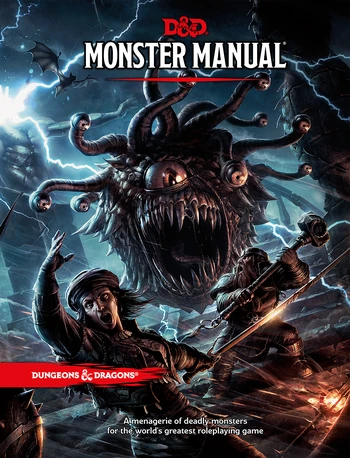
(left to right: 5.5E/2024 Monster Manual; 5E Monster Manual)
And here we go.
Dungeons & Dragons has been one of the most influential franchises for me growing up, particularly one I realized how almost every sword-and-magic RPG out there owe something to the grandfather of Tabletop Role-Playing Games. In particular, their bestiaries have always caught my mind – these entries that talk about their size, behaviour, powers… and the many ways that these creatures pose a threat to the local adventurers living in the world.
And so when I realized I was going to be doing monster reviews on this blog, Dungeons & Dragons was one of the first franchises I did, with the original version of this article written all the way back in 2019. And just like how Wizards of the Coast is revising their content, so am I.
I’ve not been the proudest of the original Monster Manual reviews. I was still figuring things out, explaining too much at some points (you guys know what D&D is now, right?) and too little at others. At the time I wasn’t sure how long the review series was going to go, whether I was going to do the earlier editions (I have a special love for my first love 3.5E, with its exhaustive manuals) or other books, whether I needed to explain the real-world mythological basis or the iterations of the monster in the earlier editions of the franchise… and ‘editions’ of the game is why we’re doing this rewrite.
In the year 2024, Dungeons & Dragons released… not a new edition, but a revised version. Alternatively called “5E-2024” or “5.5E” by the fandom, we got a new set of rulebooks that streamlined and rebalanced a lot of the older content, and a bunch of other books and gravitated towards the newer ruleset.
And this preface, I believe, is quite important – I am going to combine both the Monster Manual for the original 5E (released all the way back in 2014) and the 5.5E Monster Manual, and also shake up a lot of the formatting I’ve done for the series in general… I’ll make a completely separate page for the ‘playable races’ for sure.
For the most part, unless there are massive changes, I’ll be talking with the original 5E Monster Manual in mind, but I’ll feature a spotlight of the 5.5E and 5E versions on the topmost part of the entry. And afterwards you’ll get to see earlier versions below it. We’ll still be following the classification ordering system of the original Monster Manual (which groups similar monsters together and is far more beneficial for a monster-reviewing blog like me) but the handful of brand-new creatures will be slotted in where appropriate.
I will be doing this for the entirety of the Monster Manual, but also for the other two bestiaries, Volo's Guide to Monsters and Mordenkainen's Tome of Foes, two books that have been merged for 5.5E into Mordenkainen's Monsters of the Multiverse. It's always a pleasure for me to talk about the monsters from those two books and I did them so early in this blog that they are due for a refresher anyway. As for the rest? They'll be edited a fair bit and some of them merged, but I don't think they will be 'republished'. I'm thinking of several mega-articles for adventures as a whole (and only highlighting interesting monsters), and leave multi-page coverage for actual dedicated bestiaries and splatbooks. That's probably how I'm going to tackle a lot of the newer books as well.
A quick index on stuff:
- Creature types: Humanoid, Beast, Plant, Monstrosity, Construct, Dragon, Ooze, Undead, Elemental, Celestial, Fiend, Fey, Aberration
- Sizes: Tiny, Small, Medium, Large, Huge, Gargantuan.
- Alignment: Two axes of Lawful-Neutral-Chaotic and Good-Neutral-Evil. Books leading up to the revision have slowly been downplaying this to reduce older unfortunate implications.
_________________________________________________________________
[originally published in September 2019; revised in August 2025]
_________________________________________________________________

Aarakocra
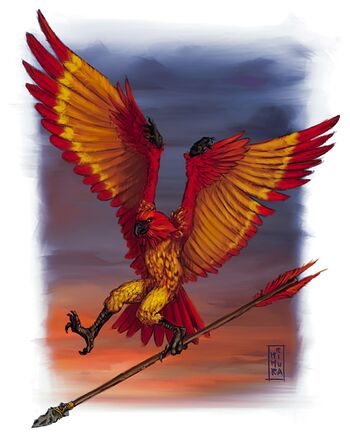

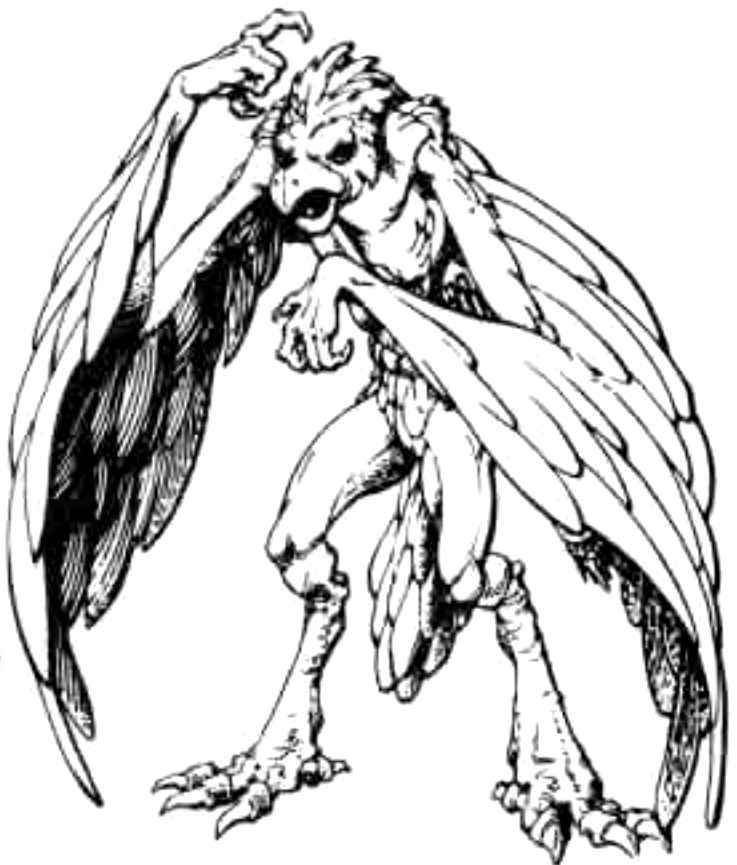
_________________________________________________________________
- 5.5E/5E: Medium Humanoid (5E) / Elemental (5.5E); Neutral Good; CR 1/4
- 5.5E: Medium Elemental; Neutral; CR 4 (Aeromancer)
The very first monster in the 5th Edition Monster Manual is the Aarakocra, or basically just ‘bird-men’. In this iteration of the game, they’ve got a primarily humanoid body, but with wings sprouting out of their backs and a clearly avian head and legs. Originally just a monster, very quickly the designers added them as a playable race, adding rules that allowed you to play as a bird-person. And we get to see the depictions of them in the 5.5E and 5E manuals respectively, with a more dynamic artpiece for the latter version that shows off the two variants described in the new manual.
The Aarakocra are characterized as being mostly heroic inhabitants of the elemental plane of air, and they hunt down air elementals. Just being boring ‘humanoids’ for most of their publication lives, 5.5E made the jump into classifying them as ‘elementals’, which is rather interesting from a mechanical perspective, but lore-wise I just kind of shrug at it.



Traditional Aarakocra are almost always exclusively depicted as just being eagle (or bird-of-prey) headed, but the new book’s art direction is focused on making more variances in their creatures, hence the pink songbird Aarakocra in the background. The text of the new book even specifies that Aarakocra resembling hummingbirds or [i]archaeopteryxes[/i] exist, which I adore! It’s a change I do appreciate, since older versions of the game would just added a brand-new species type for a slightly different concept when there’s no reason why the bird-person race can’t be made up of different birds.
And here is where I’ll talk about older versions, which I’ll mostly be brief about (or not mention) because I’ll probably break them down more whenever I review monsters for the older Monster Manuals. The Aarakocra is a D&D-original monster that debuted all the way back in the original 1st Edition Fiend Folio, but up until very recent versions they actually don’t have humanoid hands and have a more harpy-esque body layout, leading to the rather hilarious image here of them manipulating things with their feet. With the evolution of them going from savage bird-men in the mountains to an actual civilization, I do appreciate the newer design a fair bit more.


Aboleth
- 5.5E/5E: Large Aberration; Lawful Evil; CR 10
We’re jumping straight to one of the all-time classics, the Aboleth! D&D’s resident Cthulhu expy, the Aboleth is a giant underwater creature, looking like a monstrous three-eyed lamprey with a body segmented into tentacle-tails in the original 5E, and given a bit of a revision to become even more monstrous in 5.5E. The basic body structure is there, but swapping out the basic ‘movie lamprey’ mouth to it having massive segments and having the tentacle body segments more prominent makes it a fair bit more alien, yeah? Always love the three eyes layered vertically.
Aboleths have always been ‘aberrations’ in the game’s classification system. Aberrations are beings that defy physics and the rules of the world, even the magical ones. They’re Lovecraftian, and while the backstories vary from edition to edition, Aboleths tend to be classified as being ‘older than the world’, ruling the world from the primordial oceans before the gods came to reshape it. And these giant angry lampreys slink down to the depths of the world. Cowed… but they will never forget. They keep passing down their grudge genetically because they can do that, and they have a race-wide grudge against the gods and their creations. A common thread across Aboleth portrayals is that they orchestrate plots that unfold across ages, gathering magical artifacts, influence and minions for a long-running, species-wide goal.


And their abilities do extend to that! They lurk in subterranean bodies of water. Most D&D settings feature the ‘Underdark’, a subterranean layer of caves that reach deep, deep into the world. They offer worshippers and cultists ancient knowledge and power, but they use their own psychic powers to control them… but ultimately transforms their worshippers into slimy, fishy minions. Because of course they do that – even in combat! Their mucus cloud can temporarily transform you into a half-mutant slime creatures that can only breathe underwater.
And it’s got a nice set of powers too even beyond the mucus. In almost every iteration, Aboleths have psychic powers, allowing them to blast psychic waves, dominate minds or consume memories. And that’s in addition to them being a giant tentacled lamprey the size of a bear.


While I do like the more threatening, predatory 5th Edition depictions, I have a fondness for the more traditional Aboleths. The lack of an angry mouth of ‘oh this is a mean fellow’ does make the older Aboleths look a lot more sinister and calculating… although they might just be closing their mouths or have them on the underside of the body. I do really like the quasi-catfish-like vibe that the 3rd Edition Aboleth has. Notably the older versions tend to go all-in on the fish body structure, whereas 5th Edition has the Aboleth’s body be a mass of tentacles that wrap together to give the impression of an eel-like fish.
I’m not sure which feels more ‘alien’, because there’s a certain charm in a straight-up ‘giant alien psychic fish with wrong features’. And as the DM in your world, you can just choose or have all types of Aboleths just be variations of each other! Aboleths honestly deserve more love and adventures revolving around them.
_________________________________________________________________

Angel - Deva
- 5.5E/5E: Medium Celestial - Angel; Lawful Good; CR 10
The original 5E Monster Manual groups most monsters of a similar type together, so the book can talk about angels as a whole before breaking down the three sub-types. The 2024 one breaks up every group, which makes it easier for players to just rely on the alphabet and look for the ‘glabrezu’ without having to know if it is classified as a demon or a devil. But lore and flavour wise it makes more sense for me to talk about the similar guys together, so 2014 classification it is!
And… angels are a staple of Western mythology thanks to Christianity. Ever since the original 1st Edition, D&D always has three kinds of ‘staple’ angels: the devas, the solars and the planetars. Out of them, Deva is the only one based on an actual religious context, being a term equal to a god or a divine being in Hinduism. The lore of the angels tend to really change depending on the setting and the gods in it, but for the most part they serve the pantheon of “good” gods in your campaign… though it really is up to the DM on how disruptive angels are to the players. Maybe the players are evil, or the angels view morality a bit differently, or there is some ‘greater good vs. immediate good’ disagreements. Or if you prefer to be more traditional, just because someone has a statblock doesn’t mean they have to be hostile anyway. A couple of Devas showing up to help your party fight the ancient demon prince is just as legitimate a usage of the statblock as any.


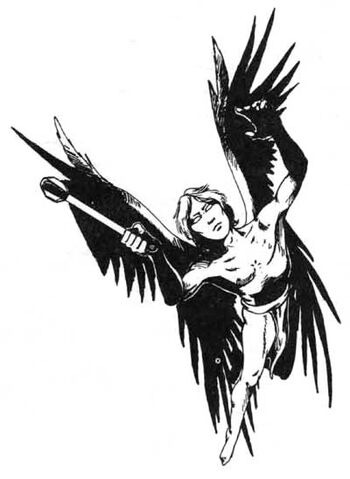
Devas in particular have a nice little quirk built into their lore, being noted as being utterly devoted and inflexible, following a ‘single driving purpose’. They are almost robotic in their inability to deviate from this mission, and they also have a bit of a superiority complex compared to us mortals. Which is why apparently the gods, who know this, only send angels in the direst circumstances which I thought was a bit unintentionally funny. They knew what they were doing when they made these winged guys, but they also take a look at them and go ‘nah, maybe that’s a bit much’.
The original 5E version has the Devas look the coolest in my opinion, having a silvery skin tone that makes them look like a living statue. The original lore note that they primarily act as messengers, and often shapeshift into regular-looking humans or animals until their aid is truly needed. 5.5E goes for a bit of a more mundane lore, reducing them to just being messengers and quest-givers. The artwork is interesting. I really like the 5.5E Deva’s hairstyle and particularly those glass-like wings, but I feel we lose a bit something special by depicting him as looking so much like a human.
________________________________________________________________


Angel – Planetar
- 5.5E/5E: Large Celestial - Angel; Lawful Good; CR 16
Next up on the hierarchy ladder is the Planetar, who in the original 5E has green, stony skin. Not really obvious from the art is that Planetars are a full size category bigger than the Deva. So the Deva is ‘medium’, meaning it’s the size of a regular humanoid creature, but the Planetar is a big winged dude the size of a bear or something. Where the Devas are noted to be messengers, Planetars are explicitly ‘weapons of the gods’ and ‘righteously wrathful’, warriors that show up to battle fiends or to unleash miracles on the behest of their gods. I do like the random little ability that Planetars are just completely immune to lies and can detect instantly if you’re lying to them.

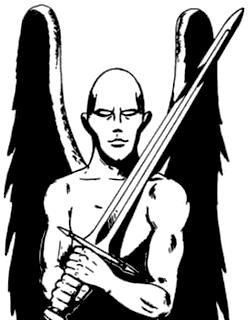
The 5.5E version still keeps the green skin, but also swaps out the huge bird-wings for a bunch of giant feathers attached to a geometric harness. It also seems like the 5.5E Planetar has a third wing (or tail)? A bit more distinctive is that his head is on fire, matching his flaming sword. I do like this distinction, the original 5E angels do all look very samey.
_________________________________________________________________


Angel – Solar
- 5.5E/5E: Large Celestial - Angel; Lawful Good; CR 21
Finally, on top of the three additional angels are Solars. Who in the original 5E just look like… dudes with bird wings, y’know? Nice art, sure, but I feel the 5.5E version improves on this in every way in making it clear that the Solars are the top dogs of the angelic hierarchy. The glowing skin, glowing holy weapons, fiery hair and most of all, three pairs of wings? Yeah, it’s unmistakable now that the Solars are the generals to the Planetars’ soldiers. More wings indicating a higher rank in the angelic hierarchy is a pretty easy visual indicator, and honestly all angels look very samey – any way to distinguish them, yeah? Even in Judeo-Christian mythology angels are a lot more varied than just ‘dude with wings’. I honestly do miss the inexplicable lack of Archons in 5th Edition for this reason in particular.

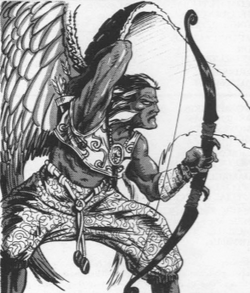

Solars are often described to be meditating or attending to their gods, and only 24 exist in the Forgotten Realms setting. The Solar itself has a lot of abilities and spells in its statblock, basically what you’d expect from the ‘final boss’ of the angels. It is kind of weird that ‘Planetar’ and ‘Solar’ are made-up names relating to planetary bodies, but then the weakest member is a ‘Deva’ instead of, like, a Lunar or something? Oh well, grandfather clause and all that.
Which is where I’m going to talk about Fallen Angels, as described in the original 5th Edition entry for angels in general, where angels who committed some evil act for whatever reason will lose their connection to the deity they serve. This severance causes the Fallen Angel to take it personally and often turn to the Lower Planes to find a new position. One of the most notable villains in modern D&D, Zariel of Baldur’s Gate fame, used to be a Solar before she fell.
_________________________________________________________________


Animal Lord
- 5.5E: Medium Celestial; Neutral; CR 20
The 5.5E Monster Manual gave us a couple of new monsters! And some of them are quite unexpected. Debuting in a Monstrous Compendium Appendix all the way back in 2nd Edition, the Animal Lords surprisingly make their way into the base set as a hefty CR 20 creature. To be fair, a lot of the complaints towards the original 5E was bad scaling for monsters at later levels, and giving us some more variation for the later levels is nice! In addition, while we don't quite get Guardinals or Archons, having this as an unexpected new celestial is definitely a nice little gap being filled.
Animal Lords are immortal spirits of legendary animals, and they appear as either a giant version of the animal they represent; a human with glowing eyes; or a corresponding furry – er, a hybrid of both features. Being spirits that represent these animals, they always have some kind of predilection or instinct that correspond to the animals they represent, so you know the Cat Lord is a capricious force of chaos knocking everything over.
The Animal Lords are Celestials that most of the time hangs out in a realm called the Beastlands, or maybe they hang out in the Feywild, but will manifest in the Material Plane if it’s in jeopardy. Animal Lords are categorized into three types – foragers, hunters and sages, each category flavouring the abilities that the Animal Lord gets. It is absolutely cute to see the lists of animals that they decided to give to each category. The hunters have staple D&D monsters like hawks, cats, wolves, sharks, snakes and alligators, but also unconventional choices like badgers and mantises. We’ve got rather common animals like vulture, stag, bear and bison for foragers… but also rabbits, bees, sloths and the ever-memetic capybaras. And the sages? Owls, mice, turtles, whales and elephants… and salmon?
So yeah. As-written, any and all animals can have an Animal Lord variant, and this is just honestly a very fun way to introduce not even an opponent, but a fancy NPC. The prose even notes that even dinosaurs or extinct megafauna would have a corresponding Animal Lord. It’s just an enemy type that really feels like it’s built for roleplaying and for shenanigans, since the whole ‘tied to a specific animal’ thing is a nice way to have them show up as a patron or an adversary to an adventuring party. One party might be granted a boon by, say, the Mammoth Lord because they helped rescued a mammoth herd from being burned down by poachers, while another party might have to accidentally face the wrath of the Anchovy God for killing too many of them during an ocean voyage.
_________________________________________________________________




Animated Object
- 5.5E/5E: Medium Construct; Unaligned; CR 1 (Animated Armor)
- 5.5E/5E: Small Construct; Unaligned; CR 1/4 (Animated Flying Sword)
- 5.5E/5E: Large construct; Unaligned; CR 2 (Animated Rug of Smothering)
- 5.5E: Small Construct; Unaligned; CR 1/4 (Animated Broom)
A staple enemy in a lot of RPG games is to imagine anything in your room… and it’s actually alive and trying to kill you! The Animated Object is a group of items that just happen to be alive because of magic. Damn wizards! In theory, you can just adapt any object into an Animated Object of your choosing (and there’s an actual spell characters can use to do exactly that), but of course the Monster Manual needs to have some limits, with 5E giving us three statblocks and 5.5E giving us four. They’re characterized as constantly following what orders they were given last, but this is one of those stat-blocks that feel like just a template for anything the DM needs.
While I will have some things to say about the 5.5E Monster Manual, I do feel like for the Animated Object’s case, the list of example causes of why an object would be animated is quite fun! The essence of a ghost trapped in a suit of armour? A fey shapeshifting a hapless person into a broom? The item just gaining sentience of years, like a tsukumogami?


Again, in theory you could just make anything into an Animated Object if you’d like. Mundane ones like stools and weapons to whimsical and weird ones like chamber pots or candelabras or teapots! The example ones given by the Monster Manual do cover a fun variety. Animated Flying Swords or any weapons in general are easy to imagine as being threatening, while Animated Armours are a pretty common video game and fantasy trope. I like the description that wizards will sometimes add in an extra enchantment in what’s basically a magical guard dog to creep out thieves by chanting ‘get out, get out…’
Animated Rug of Smothering is quite hilarious but likely to be deadly if your low-level players make light of it, and it’s got a fun Trapper-esque quality of ‘gotcha’ to it while still keeping in some sensible rules of the setting. Death by carpet, that has to be one of the more undignified ways to go out! And finally, 5.5E adds an extra Animated Broom, which is there as an additional smaller stat block (the 2024 book really likes this) but also gives us a cute little bit of flavour text saying that wizards are likely to create these things specifically because they can’t be bothered to do their own cleaning.
_________________________________________________________________


Ankheg
- 5.5E/5E: Large Monstrosity; Unaligned; CR 2
We have our first bug monster! The Ankheg is the staple ‘giant monster insect’ D&D monster, having appeared in every single edition. Their appearance has changed somewhat over the years, but the general vibe of all the nasty tropes you have about insects and everything else is smooshed together into these giant, highly-armoured brown burrowing insects the size of horses. The 5th Edition version gives it a very nice plated look with a head-crest, prominent fangs and claws, mixing in features that draw from beetles, mole crickets, earwigs and even crustaceans but not trying to mimic a specific insect. 5.5E seems to double down and give it chitinous plating more similar to a lobster or something. But ultimately the Ankheg is its own thing, and I appreciate it.

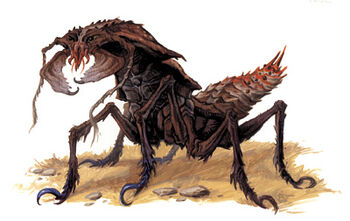

I would like to note the older versions of the Ankheg, with the 3rd and 4th edition here having a much more 'giant bug' feel, with all of the Ankheg's legs looking quite like what you'd find on a cockroach or a beetle. The 5E Ankheg, in comparison, has much more prominent, chunkier forelegs and considering how much this thing burrows through the ground, it makes a lot of sense, particularly when the massive mandibles look like they're more adapted to grab prey than anything.
The Ankheg are described to be master burrowers, hiding underground and bursting out to ambush their prey with their massive claws and acidic saliva. Because of course it’s got acidic saliva, it’s a giant fantasy bug monster! Or, well, digestive enzymes that it can shoot out at its enemy. Which also makes sense for insects!
I also like the nice descriptions of Ankhegs creating complex underground labyrinths, almost like an anthill or something except the caverns are much larger. They are pests towards farmers in this setting since they eat livestock, and just like the insects they are based on, it’s sometimes hard to properly clear out an Ankheg infestation without going down to the nests and making sure all the eggs are destroyed. Except you’re also literally going down into the nests of horse-sized, acid-vomiting bugs that can snip off your limb if you’re not careful!
_________________________________________________________________

Awakened Plants
- 5.5E/5E: Small Plant; Unaligned; CR 0 (Awakened Shrub)
- 5.5E/5E: Huge Plant; Unaligned; CR 2 (Awakened Tree)
Most Monster Manuals have an appendix of statblocks for ‘regular’ animals because they quickly find out that you don’t need a full paragraph detailing what a lynx or a bear or a gecko is. In the original 5E Monster Manual, that appendix also includes a bunch of less fantastical monsters. 5.5E moves anything that’s not a normal animal in real life and gave them their own pages and artwork. Sweet!
The Awakened Plants are different from something like a Treant or a Blight, in that they do start off as regular plants, but become sentient or sapient because of a spell like Awaken or from power from realms like the Feywild. The Awakened Shrub described here can take the form of anything from a flower cluster to forest bushes to the version in the artwork – topiary cut into the shape of bunnies and foxes.
Awakened Trees, meanwhile, can just… disguise itself as a tree. Which is going to be a bit of a common theme in a lot of these D&D monsters that can disguise themselves as regular stuff until you accidentally disturb them. They are likely based on the Huorns from Lord of the Rings, who are more sentient than trees but not quite actual tree-people like the Ents/Treants. The Monster Manual describes how Awakened Trees could look bright and beautiful with strange colours and flowers if they are awakened by Feywild energies (as shown here), or all gothic and emo and look like a dead tree if awakened by Shadowfell energies instead. Monster variation! Always neat.


Axe Beak
- 5.5E/5E: Large Monstrosity; Unaligned; CR 1/4 (Axe Beak)
- 5.5E: Huge Monstrosity; Unaligned; CR 5 (Giant Axe Beak)
Another one that was originally stuffed into the appendix is the Axe Beak, which is a giant bird with a beak shaped like an axe! It’s not actually metal, it’s just shaped like an axe. It’s honestly just a weirder version of an already existing animal, the Terror Birds of family Phorusrhacidae. Axe Beaks have been around since the first edition, and have been depicted as just being a weird ostrich, a fuzzy arctic design in 5E, a grody vulture-esque design from the recent live-action movie… but I really love the glorious art that 5.5E gives us, giving the Axe Beak super-bright colours like a toucan.


In addition to having huge wedge-shaped beaks that can break foliage (and adventurer bones), Axe Beaks are also often raised as mounts if raised from young. Final Fantasy, anyone? I’ve always liked Axe Beaks, sometimes you just need some slightly weirder animals.
_________________________________________________________________


Azer
- 5.5E/5E: Medium Elemental; Lawful Neutral; CR 2 (Sentinel)
- 5.5E: Medium Elemental; Lawful Neutral; CR 6 (Pyromancer)
Another staple monster of D&D that has shown up in almost every edition is the Azer… who I have to keep reminding myself aren’t actually dwarves on fire. Azers are native to the Elemental Plane of Fire, and just resemble dwarves, and they have metal bodies and an inner form of fire that makes them look like they’ve got fancy beards.
Azers are noted to not reproduce in a traditional sense, but instead forge each other. It’s a nice description of how alien these elemental beings can be where something basic like reproduction has them go through an almost robotic sequence of forging new bodies, then transplanting fragments of a parent Azer’s ‘inner flame’ to the new one. Everything about their culture seems to be related to forging and crafting. They’re noted to be in eternal war with the Efreets that rule the Fire Elemental Plane, where the Efreets commissioned the Azer to create their palaces, and then tried to enslave or silence the entire race. It failed, and now the Azer are at war against the Efreets.

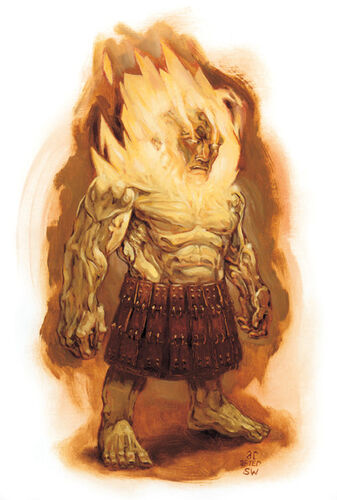
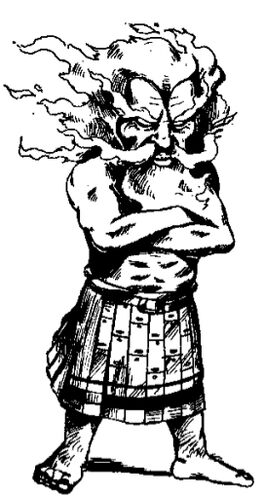
This is where I feel the 5.5E Monster Manual fails, in my opinion… the writeup for the Azer is like, maybe 3 sentences. One sentence for the Azer race, and one sentence each for the two stat blocks they cram into a single page. It’s honestly dumbing down substance for style and the convenience of having each monster take up single pages, but at that point maybe don’t print two stat blocks and just add a single box detailing the extra attacks given to a variant? It’s one thing if you have two blocks for a monster that’s ‘just a beast’ like the Axe Beak, it’s another when you’re reducing so much from the original. I feel like as pretty as the new Monster Manual is, the sheer elimination of ecology and lore for many of its entries is a huge net loss.
_________________________________________________________________


Banshee
- 5.5E/5E: Medium Undead; Chaotic Evil; CR 4
Banshees draw their names from a specific Irish supernatural being, but has evolved in modern media to just end up meaning ‘screaming ghost lady’. And D&D’s Banshee is one of the many, many different undead types that they feature in their repertoire of ghostly undead monsters. For most of D&D’s lore, Banshees are flavoured as being specifically the spirits of dead female elves who disrespected beauty – those who used beauty to corrupt or control others, in particular – and would be cursed into being banshees upon their death. They’re bound to the places where they die, and are still obsessed with beauty, hoarding objects but also being enraged whenever they see their now-horrid reflection in a mirror. All this mental anguish causes them to just scream, you know? The Banshee’s scream is so powerful that in addition to dealing psychic damage, weaker creatures just drop dead. The original 5E Monster Manual has a particularly great artwork showing a Banshee whose body is half-torn-apart.
Interestingly, the original description makes note about how the elves who suffer the Banshee Curse will change even when they are alive. They experience no happiness, continually experience distress near the living, and their minds and bodies continue to decay as they transform into a Banshee with presumably no way to stop it.


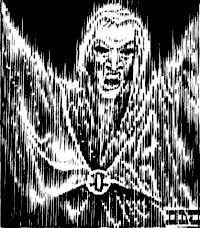
5.5E made a conscious attempt to try to ‘genericize’ some of these monsters, which I feel is just a way to allow DMs to be more flexible with the origin stories and appearances of monsters that have origin stories that are a bit too specific. Banshees being one of them! The association with elves and beauty is still there in the lore, but it’s just a specific fear among elven communities, and ‘any tormented soul’ can rise as a banshee, and not just beauty but also bitterness or sorrow. Notably, the banshee in the background of the 5.5E art also seems to be a man.
I feel this is a nice way to explain if you just needed a Banshee for an encounter but it’s not near an elven graveyard. If you wanted the traditional D&D Banshee you could just ignore the ‘any soul’ bit and just make the Banshees still be elves obsessed with beauty. Or you could flavour it as ‘Banshees of Sorrow’ and ‘Elven Banshee’. Or something along those lines.


Basilisk
- 5.5E/5E: Medium Monstrosity; Unaligned; CR 3
Basilisk is one of those creatures who has multiple ‘canon’ iterations in real life, with various overlap with the cockatrice and being portrayed as some combination of snake, chicken, or wyrm. D&D’s Basilisk has been quite consistent in portrayal, being a stout eight-legged dinosaurian creature with the ability to petrify living things in its sight. Older depictions would have a more draconian look, but since 3rd Edition onwards the Basilisk has been consistently drawn as being a thick-set fanged dinosaur with a body relatively close to the ground. A row of glowing crystalline spines run down the Basilisk’s body, which is a nice nod to its status as a more supernatural or magical beast – a ‘monstrosity’, to use the game’s terms.
Basilisks live mostly underground, but also in other habitats as well. I like the little advice given in the original Monster Manual – “no one carves statues of frightened warriors”, because the statues of the Basilisk’s prey litter its lair. They turn opponents into stone statues with their gaze, and then consume the stone – which returns to flesh in the Basilisk’s gullet.


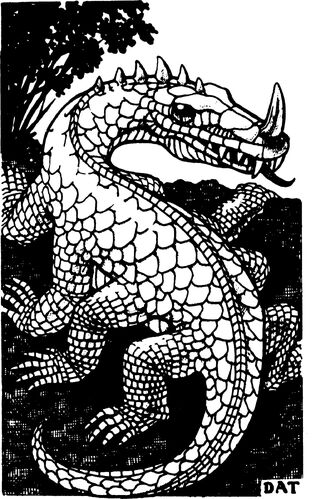
There are some neat little details, too, with how Basilisks can actually be trained to avoid meeting the eyes of its masters. Another fun detail is that if your party has enough alchemist skills, they can extract some fluids from the basilisk’s gullet glands as an antidote to the petrification, sort of like a magical version of an anti-venom. Pretty neat stuff.
_________________________________________________________________


Behir
- 5.5E/5E: Huge Monstrosity; Neutral Evil; CR 11
Going from one multi-legged reptile to the next is the Behir. Which at first glance looks like a dragon, but it’s not! It’s actually a plot point that Behirs are ‘merely’ monstrosities but often war against dragons for territory. They’re twelve-legged creatures that tend to be blue, have heads of dragons and breathe lightning. Apparently the original idea was for the Behir to be a ‘centipede-crocodile’. Over the years, Behirs have gained more and more dragon features until 5th Edition realized that the whole point of these guys is that they're not dragons, and they lost their scales for a more eel-like or salamander-like appearance in 5E. I like it a lot, and a nice way to show that not all reptilian monsters need to be some variation of a dragon to look impressive.


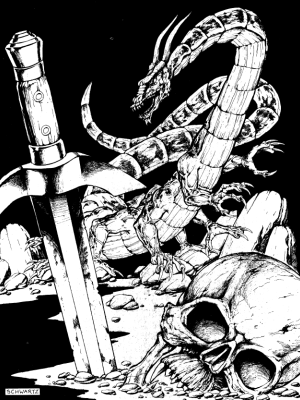
Behirs scuttle around caves and pits where other creatures find hard to navigate, the way that real-life cockroaches or centipedes pick their lairs in someone’s house. And the Behirs can either scuttle or slither, depending on its needs. It ambushes its prey, before swallowing them and entering periods of dormancy in its lair to digest it. The backstory is that the Behirs were originally pets of the Storm Giants, who either created or bred the Behirs as a weapon to fight against the dragons in ancient wars. Dragons themselves view Behirs as abominations and hunt them on sight, while Behirs try to devour younger dragons or dragon eggs.
Not the most exciting creature in the Monster Manual, but I do have a bit of an appreciation with the mental image of these many-legged monsters scuttling and slithering down tunnels. They’re also intelligent enough to speak and understand languages, which is another interesting wrinkle.
_________________________________________________________________


Beholder
- 5.5E/5E: Large Aberration; Lawful Evil; CR 13
The original version of this article ended at ‘Cambion’, but I think I should really end at the poster boy for D&D monsters… the Beholder. The most iconic monster bar none among the thousands of D&D monsters, the Beholder is a simple yet impressive design – a giant head with a big mouth and a big eye, and a set of tentacles each ending in eyeballs that shoot different rays. As illustrated perfectly in the 5.5E and 5E art, the Beholder can terrifying or played to be a bit more cartoony, which isn’t something you can say for all monsters. There’s just a nice ‘mascot’ feel for the Beholder, and the D&D publishers capitalized on it. Notably, while the other core books changed their covers, the Beholder is still the prominent feature on both versions of the Monster Manual.
Considered an ‘Aberration’ similar to the Aboleths above, these giant eyeballs clearly defy logic in how they operate. And there has been quite a bit written about Beholder lore (in 5th Edition, Volo’s Guide to Monsters in particular has a huge section about them) and over the history of publication the Beholders’ main thing is that they are xenophobic perfectionists. They hate everything and think everyone’s out to get them, and each individual Beholder is always different enough that they think they’re the best and most perfect Beholder out there. Other Beholders are lesser than them, and other creatures are far beneath them. It’s an interesting little quirk, because this means that unlike most other ‘boss’ enemies, it’s quite unlikely for Beholders to actually work together since they all hate each other and see other Beholders as ‘flaws’ in perfection. And the Monster Manual wants you to customize your Beholders! Some may have scales or fins, some might be blue or brown or green, some might have a different arrangement of eye-tentacles, some may have a round head or a realistically proportioned skull... whatever each Beholder looks like, they always consider themselves to be the most perfectest of the perfect Beholders ever.



In 5E at least, they also reproduce and bring to life new Beholders by dreaming, because so alien are they to the Material Plane that their thoughts can warp and create even more Beholders. And even if they reproduce, the little baby Beholders and the big parent Beholder all think they’re better than everything else there. Because of course they are! The perfect life forms, these Eye Tyrants.
In combat? Beholder lairs are super weird because of the fact that they’re large floating eyeballs that can shoot disintegration rays, so they could do a lot of interesting stuff in their lair. But the most terrifying thing about the Beholder is their central eye, which constantly emits an anti-magic field that disables magical effects. You need magical effects and spells to fight, especially to fight a flying monster! And the Beholder’s ten eyes have completely different effects: charm, enervation, fear, paralysis, petrification, sleep, slowing, telekinesis… and the two best ones, death and disintegration. It’s not a good time to fight a Beholder for the player characters, but always one for the players!
_________________________________________________________________


Beholder – Death Tyrant
- Large Undead; Lawful Evil; CR 14
Being a mascot monster means that Beholders have had a lot of variations over the years. We’ll cover some of them in later 5th Edition material, but the Monster Manual gives us two versions. The first one being the Death Tyrant, which used to just be an undead Beholder… but is a bit funnier now! 5th Edition lore has it that Death Tyrants are created when a Beholder dreams… and in the aberrant dreams it has, sometimes it dreams of death and what’s beyond death, and oops, dreams become reality and the Beholder is transformed into an undead.
5.5E gives several more alternate explanations to a Death Tyrant’s origin – journeying to the Far Realms, a Beholder exploring lichdom, regular necromancy on a Beholder corpse… but the ‘accidental reality-warp via daydream’ explanation is the funniest bar none.


The visual imagery is neat, just having a monstrous skull where the central Beholder face used to be. But my favourite part is that the Death Tyrant still has glowing beads of light around it, where the eyestalks would normally be if the flesh was still there. That’s a cute and creative way to show off just how weird this thing is, and to identify it as a Beholder variant instead of just a random floating skull. The new 5.5E artwork really made it look impressive by exaggerating the giant orbs. Older editions just have a zombiefied Beholder corpse, which... isn't that distinct, really.
The little eyes still do basically the same thing as a Beholder, but instead of an anti-magic cone, the Death Tyrant’s central eye unleashes a negative energy cone that prevents healing, and also transforms anything that dies in its gaze into a zombie under its control. Unlike regular Beholders who are content to lord in their little bases, Death Tyrants are more likely to venture out into the world with their armies, crushing cities and building its army of zombies.


Beholder – Spectator
- 5.5E/5E: Medium Aberration; Lawful Neutral; CR 3
The heck, this is a little guy! Look at that 5.5E art, he looks so nervous! This is a smaller variant of the Beholder, with four tentacles instead of ten and being much smaller. And you might be tempted to think it’s just a baby Beholder, but it’s not! Spectators are summoned using a ritual involving four Beholder eyestalks from… from whatever plane that the Beholders come from. And they have the personality of a very professional security guard instead of the monstrous mentality of a true Beholder.
Spectators will serve its summoner for 101 years specifically, normally guarding a location or a treasure. It’s specifically noted to be intelligent enough to talk with whoever approaches it, but doesn’t have any ambition of its own and won’t abandon its post. The 5th Edition entry notes that the Spectator is a quirky soul due to years of isolation, and some of them do things like ‘invent imaginary enemies’ or ‘try to adopt the voice of its summoner’. That’s cute!
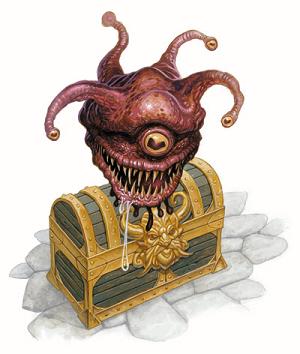

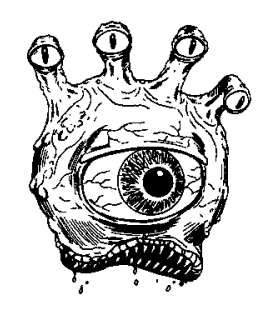
As a side note, 1E and 2E had Spectators have a much weirder mouth that takes up the entirety of their lower side. It's a lot more distinctive, but probably not the most appropriate one to have for a being whose whole point is 'small, friendlier Beholder'.
And when Spectators finish their duty? Sometimes they disappear, but sometimes they’re just free to do… whatever they want. Sometimes they go nuts from isolation and just revel in it. That just screams ‘recurring NPC’, doesn’t it? It’s such a weird thing to see something so close visually to a Beholder but also so different personality-wise.
In Doylian terms, the Spectator is basically a way for your DM to let your party fight a Beholder at a much lower level, since its four eyes shoot four of the weaker rays (confusion, fear, wounding and paralysis). But having it have such a weird, quirky personality makes it probably my favourite of the Beholderkin.
Seeing new art for these guys is cool, and blending it with your old reviews is a nice touch
ReplyDeleteI was debating a lot on whether I was going to do a second set of articles just doing 5.5E, but it felt really weird going "please refer to my old 5E articles" like a dozen times in the same article. It also... wasn't the most interesting discussing differences in art and maybe the handful of creatures with a bit of altered/expanded lore?
DeleteAdd that to how I was doing MTG review rewrites anyway, and this led me to finally bite the bullet and just go for a full D&D review rewrite. I wrote a lot of these in 2018-2019 too, where I'm still a greenhorn in making monster reviews and blog stuff as well, and I'm just not the proudest about them? So yeah. The 2024 rules set was just the final impetus to properly refurbish everything.
They did have some good stuff. A line I will remember from your old beholder review is this: "See any xenophobic race could view us inferior species with *bodies* to be filth, but the Beholder takes it to a hilarious degree." And then the 3 counts of "Inferior!" It made me love how much of an asshole all beholders are to everything around them.
DeleteI'm happy to see some of my older reviews left an impression!
DeleteThey are a nice skeleton to work off of and I try to echo a lot of what I wrote back in 2019 into my newer reviews... but a lot of times I just go into a lot of tangents about what the real-world mythological inspiration of the monster is; or the pop culture jokes; or just talk about the visuals without necessarily reviewing and talking about the monster as a whole package. Which I still catch myself doing even now, but at least with the power of hindsight and actually having played a bunch of 5E games, I do imagine these review are a fair bit more informative to read.
I was also rushing a lot through the monsters that I don't care about, which isn't fair. And while it did admittedly cause the articles to essentially double in size, I feel like I'm doing all the monsters justice. (Besides, whenever I get to doing other Monster Manuals -- like AD&D -- it gives me a 'point to an older article I did' if I have already spoken about the creature at length there)